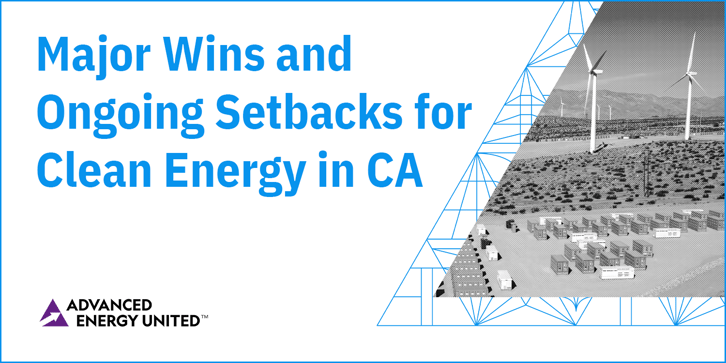.png?width=726&height=363&name=Blog%20CA%20Must%20Embrace%20Advanced%20Energy%20Technologies%20to%20Combat%20Challenges%20(1).png)
This year’s California legislative session was filled with twists and turns as lawmakers faced intense pressure to tackle skyrocketing energy bills and prepare the grid for more extreme weather. Amidst these challenges, Advanced Energy United (United) achieved significant victories for advanced energy technologies—but we also experienced some frustrating setbacks in key areas that we will continue to focus on in the coming years.
Legislative setbacks advancing energy affordability and distributed energy resources
A major challenge in advancing clean energy legislation this session was balancing lawmakers’ immediate concerns about soaring energy costs with the long-term benefits of deploying advanced energy technologies.
Unfortunately, heightened concerns over energy affordability, fueled by misguided “cost-shift” arguments, led to the defeat of key legislation designed to maximize the benefits of readily available distributed energy resource (DER) technologies. The veto of Senate Bill (SB) 1374, which would have restored the ability of schools and apartment buildings to fully utilize their on-site solar energy, was the most recent example of this trend, with Governor Newsom stating in his veto message that the bill would “compound the challenge of electric bill affordability.”
Other setbacks included the defeat of Assembly Bill (AB) 2256, which would have required the California Public Utilities Commission (CPUC) to include the true value of nonenergy benefits in its net energy metering (NEM) tariff, and AB 1999, which would have capped fixed charges on investor-owned utility (IOU) electric bills at $10 per month.
The defeat of AB 1999 was especially notable. Without it, the CPUC retains full power to authorize high fixed charges, diminishing the financial incentive for customers to invest in energy efficiency and electrification technologies. Although the current CPUC-approved cap of $24.15 per month in fixed charges is a moderate one, the absence of legislative safeguards means this cap could increase significantly in the future, further harming the adoption of clean energy solutions.
California’s $56 billion budget deficit also loomed large this session, leading to significant cuts across several clean energy programs. Zero-emission vehicle (ZEV) programs lost about $500 million, the Self-Generation Incentive Program (SGIP) saw a $125 million reduction, and the Demand-Side Grid Support (DSGS) and Distributed Electricity Backup Assets (DEBA) programs lost $530 million. Despite these cuts, United successfully led a coalition to secure $75 million to keep the DSGS and DEBA programs operational for the 2024-25 fiscal year.
Groundbreaking legislative wins in neighborhood decarbonization and advancing grid-enhancing technologies and advanced reconductoring
Even amid those setbacks and challenging trends, United’s major victories made significant and lasting strides for advanced energy technologies.
One of the session’s key accomplishments included securing significant funding for United’s priorities in the $10 billion climate bond, which was approved by the legislature and will appear on Californians’ ballots this November. By leveraging strategic relationships with supportive legislators, United ensured the bond included $325 million for clean energy transmission projects, including advanced transmission technologies, and $50 million for long-duration energy storage and DERs. We are optimistic about the bond’s passage, with a recent statewide poll showing that 65% of likely voters have indicated they would vote yes on it.
Other successes included defeating measures that would have impeded the deployment of advanced energy technologies. One particularly challenging bill was AB 3111, which aimed to impose onerous and costly reporting requirements on DER and virtual power plant (VPP) providers. After passing the Assembly, the bill was defeated in the Senate through a coordinated effort with industry allies.
In addition, United was successful in defeating AB 3121, a last-minute effort to slash funding for vital energy programs, including SGIP, Solar on Multifamily Affordable Housing (SOMAH), and the California Schools Healthy Air, Plumbing, and Efficiency Program (CalSHAPE) to give IOU ratepayers a one-time bill credit of about $30. To defeat this high-profile bill, we worked in partnership with a large coalition of clean energy, housing, environmental justice, and education allies.
The most lasting successes, however, came from the signed legislation championed by United. This includes SB 1221, a groundbreaking bill that will enable the launch of neighborhood decarbonization pilots, paving the way for a long-term strategy to transition away from gas usage in buildings in an affordable and equitable manner. These pilot projects will help disadvantaged, low-income, and environmental justice communities access clean home appliances and clean indoor air. This achievement took the work of dozens of state and national organizations—a coalition we were proud to have an active role in.
Additionally, United co-led a different coalition working to secure the passage of SB 1006 and AB 2779. These bills will accelerate the deployment of grid-enhancing technologies (GETs) and advanced reconductoring technologies, increasing transmission capacity. These technologies offer a fast and cost-effective way to modernize California’s grid, meet increasing electricity demands, and improve efficiency, safety, and reliability.
Looking ahead for opportunities in 2025
When session reconvenes in January, a new batch of lawmakers will have the opportunity to champion solutions that address California’s ongoing energy challenges. As energy costs continue to rise and the impacts of climate change intensify, there is a critical need to implement policies that embrace innovation, optimize our energy system’s efficiency, and accelerate the deployment of advanced energy technologies like DERs, VPPs, advanced transmission technologies, and managed EV charging.
United is prepared to lead the charge, continuing our advocacy to create a resilient, affordable, and clean energy system that benefits all Californians. Only by prioritizing these innovative solutions can California achieve a sustainable, affordable, and equitable energy future.
![]()




